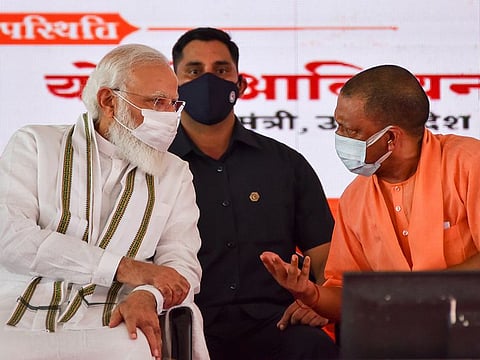End of Farmers’ Protests: All eyes on key UP elections in India
Overwhelming thrust of poll campaign in UP has changed for better thanks to Modi and Yogi

Emotional scenes were witnessed at the Delhi borders as the farmers finally unpitched their tents, preparing to go home. Vacating protests sites in Singhu, Tikri, and Ghaziabad after their year-long agitation, many farmers sang, danced, prayed, performed religious rituals such as havans and kirtans.
They danced the bhangra, distributed sweets and free food in langars or communal kitchens, even apologised to those they forced themselves upon as unwelcome neighbours.
As they packed and bundled their belongings, back onto the tractor-trailers and minitrucks, Delhiites heaved a sigh of relief. As did the police and law-enforcement agencies, tasked with maintaining the peace, without giving provocation, in a highly sensitive situation. As the dust settles on the Delhi borders, all eyes are now on the forthcoming elections in Uttar Pradesh and Punjab.
Yes, the farmers had defeated the government, forcing it to repeal the allegedly unpopular farm laws. These laws, as observed in previous columns, went against the interests of a relatively small section of their middle and high-income brethren from Punjab, Haryana, and Western Uttar Pradesh.
These were farmers who wanted, and now obtained, state support, subsidies, and guaranteed income at tax-payers’ expense, being themselves tax-free. Whether or not their produce was needed by the nation, they had got assurances that the state would keep buying it from them.
What happened to the grain, whether it rotted in godowns, whether it was eaten by rats and vermin, or even diverted and sold off to mills instead of reaching the public distribution system – none of this was their concern. They had managed to coerce the government to back off and concede to all their demands.
These included minimum support price, waiver of all cases, release of offenders, and so on. On November 29th, a year after their protests had commenced, the Parliament had repealed the farm acts.
Victory parades and felicitation
Victory parades, garlanding, and felicitations on the national capital regions borders, reminiscent of celebrations of war heroes, marked their departure. Among the victorious farm unions, the Samyukta Kisan Morcha, the largest and most influential group consisting of some 40 farmers’ unions, which had spearheaded the agitation, also suspended their protest on Thursday, December 9th. As they parted, they hugged each other and promised to keep in touch, to keep their solidarity strong.
Some farmers said they felt sad to leave their homes away from home. They had grown so used to their new, protest-intensive lifestyles. Perhaps, there was a sense of emptiness at the end of it all. One of them said, “This is my last breakfast here. I will miss this place when I go back to Punjab.” He was also probably wondering what he had fought for. What had he really won?
Wasn’t this a pyrrhic victory, empty of real benefit to the nation? Did holding the nation hostage for their own interests really show the farmers in a good light or earn them popularity among the larger populace? These are questions that would surely haunt and worry the more thoughtful and sensitive among them. Also, for how long would the status-quo last? How long could they fend off reform? Especially after losing the moral high ground?
Eye on UP elections 2022
True, the Modi government has backed down, but the obvious reason for this was the forthcoming assembly elections in Uttar Pradesh and Punjab. Politics is the art of compromise. Staying in power and winning elections trumps all other priorities.
If the BJP comes back to power, as opinion polls have already started to predict, the government is sure to bring back farm reforms, even if in a different garb. So the farmers’ victory, if it is regarded as genuine, will only prove temporary.
In the meanwhile, in the just released ABP-CVoter Third Opinion Poll, the ruling BJP is ahead in 4 states, with a hung assembly predicted in Punjab.
The contest will be hard fought in four states – UP, Manipur, Goa and Uttarakhand, with BJP to come out on top. In Punjab, however, it is Aam Aadmi Party (AAP), headed by Arvind Kejriwal, which is supposed to have the lead, without any single party getting a clear or decisive mandate.
In UP, BJP’s election machine is in full swing. A slew of mega-projects, some pending for as long as forty years, are being inaugurated, proceeding ahead in full-swing, or being completed. This ribbon-cutting spree, as the opposition has called it, is, nonetheless, creating a positive momentum in favour of the BJP.
In the last elections in 2017, the BJP had won a whopping 325 of the 403 seats. This time it may win less, its numbers coming down to 212-224, according to the poll. Yogi Adityanath, the present incumbent, is still the most popular chief-ministerial candidate and clearly the frontrunner.
Psephology is an inexact science. In the past, it has proven unreliable. But pre-election polls do give us some basis, some idea of what is to come. Much will change between now and February 2022. But what the departing farmers show is that politics in India trumps all else including economic and social progress.
Here is where the BJP led by Narendra Modi has shown a significant and decisive break with the past. Even though it has eaten humble pie when it comes to the farm laws, its plan in UP for renewing its mandate is progress, development, efficiency, freedom from corruption and lawlessness.
Yes, appeals to caste, creed, religion, and other local factors cannot be wished away altogether, but the overwhelming thrust of the campaign in UP has changed for the better thanks to Modi and Yogi. Now real issues — how to secure a better life for everyone — are centre-stage. Not merely politics of identity.
Sign up for the Daily Briefing
Get the latest news and updates straight to your inbox




